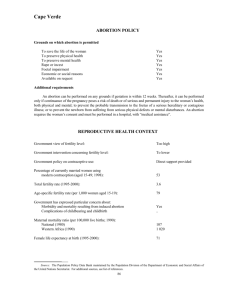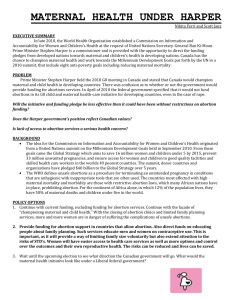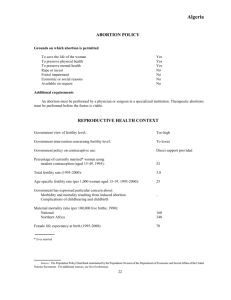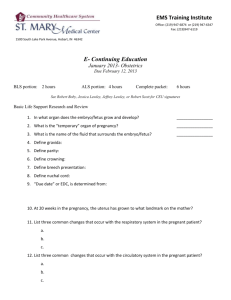South Africa
advertisement
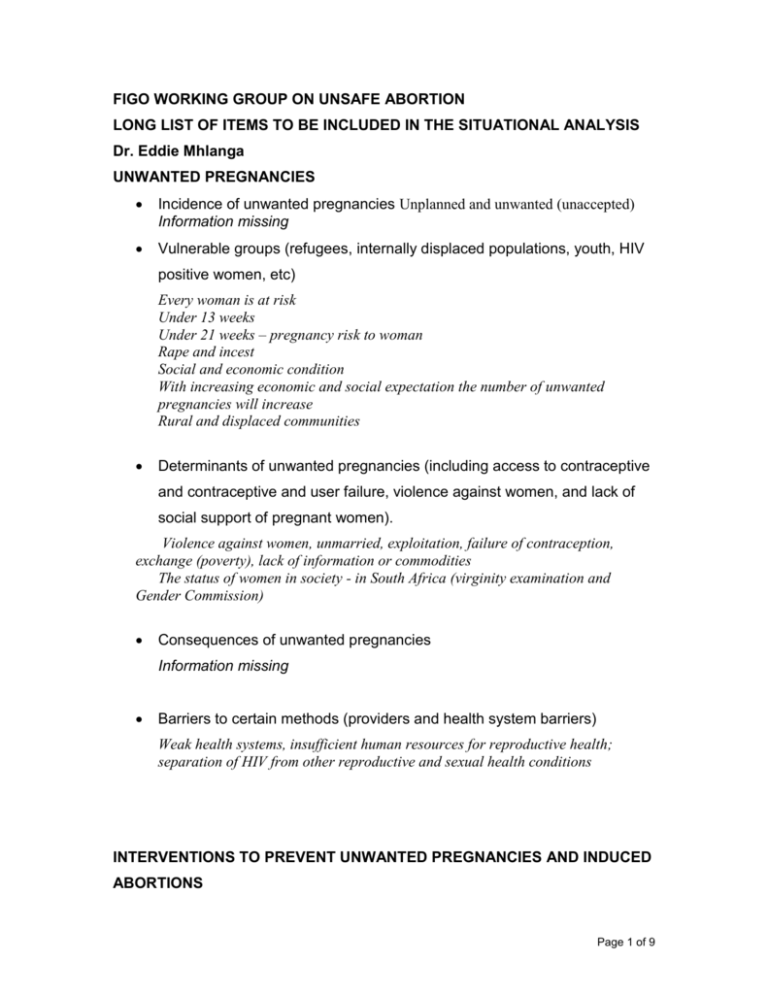
FIGO WORKING GROUP ON UNSAFE ABORTION LONG LIST OF ITEMS TO BE INCLUDED IN THE SITUATIONAL ANALYSIS Dr. Eddie Mhlanga UNWANTED PREGNANCIES Incidence of unwanted pregnancies Unplanned and unwanted (unaccepted) Information missing Vulnerable groups (refugees, internally displaced populations, youth, HIV positive women, etc) Every woman is at risk Under 13 weeks Under 21 weeks – pregnancy risk to woman Rape and incest Social and economic condition With increasing economic and social expectation the number of unwanted pregnancies will increase Rural and displaced communities Determinants of unwanted pregnancies (including access to contraceptive and contraceptive and user failure, violence against women, and lack of social support of pregnant women). Violence against women, unmarried, exploitation, failure of contraception, exchange (poverty), lack of information or commodities The status of women in society - in South Africa (virginity examination and Gender Commission) Consequences of unwanted pregnancies Information missing Barriers to certain methods (providers and health system barriers) Weak health systems, insufficient human resources for reproductive health; separation of HIV from other reproductive and sexual health conditions INTERVENTIONS TO PREVENT UNWANTED PREGNANCIES AND INDUCED ABORTIONS Page 1 of 9 Support for Prevention Contraception both modern and tradition Information and access Life skills programme - ? for adults Economic empowerment Male role in reproductive health National and local provision of contraceptive technologies Contraceptive information and services including EC Insufficient promotion of contraception – contemporary and traditional Overall and method specific prevalence rate Specific methods (2003) Female sterilization Male sterilization Pill Injectables IUD Male condom 14.4 0.7 11.1 28.4 1.0 4.7 Which methods are approved and sold in the country? Injectables (Depo Provera, NurIsterate) Oral contraceptives (COC and POC) Condoms (male > female) Female + male sterilisation, IUCD (inert and copper containing) IUCD hormone containing Foams, creams and gels (spermaticides) Which methods are distributed for free or at subsidized price through public or private health networks in the country? Injectables (Depo Provera, NurIsterate) Oral contraceptives (COC and POC) Condoms (male > female) Female + male sterilisation, IUCD (inert and copper containing) IUCD hormone containing Foams, creams and gels (spermaticides) Which is the real availability of methods in the public health services Page 2 of 9 Information missing What data are available on access to methods by young people, unmarried women and other marginalized groups (rural people, indigenous groups, refugees IDPs). Information missing Comprehensive Sexuality Education What is the current situation of knowledge among women and men on sexuality education? Information missing Are there governmental programs for comprehensive sex education? YES How comprehensive is the coverage of sexuality education programs? Out of school youth? In-school youth – secondary level, primary school. tertiary level adults National programme for sexuality education with NGO participation – PPASA, loveLife, Ipas How comprehensive and adequate is the training of teachers to provide sexuality education? May be need for strengthening of life skills Which is the technical orientation (scope and content) of the existing programs? Information missing Social protection of pregnant women and mothers of small children Is employment of pregnant women protected by law during pregnancy and after delivery and for how long? Page 3 of 9 Maternity leave, UIF ??? Is the law enforced? Information missing How long is the legal parental leave? Is it paid? Is it the same for all populations within the country? Information missing Is maternal breast feeding effectively protected for working women? How is the compliance with the law on parental leave and maternal breast feeding? Information missing Are there sufficient whole day nurseries, preschool and school for the children of working women? Information missing Adoption Is there support for women who wish to give baby to adoption? Information missing Is there an effective procedure for adoption in the country? Information missing ABORTION Incidence Number of legal or officially reported induced abortions (1998) 439,334 (1999) 4 45,000 (2000) 4 51,132 (2003). 3 70,100 Reliability of data Underestimation, Not all provinces report of all TOPs performed ; illegal & unsafe abortion still common Sources of data Officially registered legal procedures Page 4 of 9 UNSAFE ABORTION Incidence unknown What data are available on the magnitude and severity of the problem of unsafe abortion? Number of admissions in 47 public hospitals in 9 provinces 2000 - 362 (282 to 441)/100.000 = 3,62 per 1000 women aged 12-49 1994 - 375 (299 to 451) 100,000 = 3.75 per 1000 women. aged 12-49 Source of data Confidential Enquiry into Maternal Deaths Characteristics of women who come for abortion (age, place of residence, marital status, income) Characteristic of providers of unsafe abortion and method used Medicinals, chemicals, objects (needles, wires), enemas, chloroquine, castor oil, dettol (antiseptics), physical, suicide Availability of misoprostol, is it registered/approved, what indications? Misoprostol available – misuse and use in obstetrics and gynaecology Distribution channels, cost? Quality of the care of women consulting for complications of abortion Which methods are used in the country for incomplete abortion? Who can provide these methods? Curettage still done in a significant proportion of cases Which is the real availability of those methods in the public health services, and how much they cost? Information missing Page 5 of 9 How is the access to treatment of incomplete abortion services by young people, unmarried women and other marginalized groups (rural people, indigenous groups, refugees, IDPs)? Information missing Is physicians and other health professionals training following WHO recommended methods for treatment of incomplete abortion? Lack of expertise in diagnosing and managing the seriously ill women – Saving Mothers Report Is the country implementing WHO guidance? Guidelines for management of causes of maternal mortality – early pregnancy losses Consequences of Unsafe Abortion The abortion related maternal mortality Maternal Mortality Ratio, reported 2001 575 (deaths per 100,000 livebirths).8 Maternal Mortality Ratio, adjusted 2005 400 (deaths per 100,000 livebirths).8 MMR ranges between 270 and 530 FAILURE TO MONITOR MATERNAL DEATHS LEADS TO NOT BEING ABLE TO NOTE IMPROVEMENT AND DETERIORATION Magnitude and severity of complications of unsafe abortion Sterility and chronic pelvic pain, depression Reduced productivity, schooling Death aggravated by HIV epidemic – deaths increased by 20% from 1998 to 2000 – 2004 (Saving Mothers) Social impact of maternal deaths – social deprivation, economic downsizing Cost to the health system – immediate care with intensive care and chronic medications for rehabilitation Page 6 of 9 Is there an established national level mechanism for monitoring and evaluation of maternal mortality and morbidity resulting from unsafe abortion? Information missing Cost of unsafe abortion to the health system, women and families LEGAL SITUATION OF ABORTION AND REGULATORY FRAMEWORK International standards ICPD Millennium Development Goals National Laws Abortion and Sterilisation Act, 1975 Choice on Termination of Pregnancy Act, 1996 Sterilisation Act, 2000 CTOP Amendment Act, 2004 Notification of and Confidential Enquiry into Maternal Deaths To save the women’s life YES To preserve women’s physical health YES To preserve women’s mental health YES To preserve women’s health (no specification) YES Pregnancy resulting from rape YES Severe fetal malformation YES Socioeconomic reasons YES Women’s choice YES Regulatory framework-key elements TENENTS OF CHOICE ON TERMINATION OF PREGNANCY ACT, 1996 < 13 weeks Upon request Information on alternatives and dangers – nurse or doctor 13 – 20 weeks Page 7 of 9 Upon request AND social & economic condition, rape or incest, detrimental to life of the woman, severe congenital abnormalities – doctor/midwife to consult another doctor/midwife, doctor implement > 20 weeks according to the LNMP Detrimental to woman’s health Detrimental to foetus’ health Severe congenital abnormalities - Doctor/midwife to consult another doctor/midwife, doctor/midwife implement Only the consent of the woman is required A woman is a female of any age Those under 18 years are advised to consult their parent(s), guardian, family friend, etc. on condition that should the minor choose not to consult, TOP will not be denied TOP service Those unwilling to provide TOP on basis of conscious, must inform the woman on her right to TOP, and to refer such a woman to someone who will provide the service Registered nurses and midwives trained for termination of pregnancy services Provision of Legal Abortion Services Is the law being complied with for each legal indication? Information missing Which methods are used in the country for legal abortion? D&C Misoprostol MVA Prostaglandins – E2, F2 alpha, gels and tablets Hysterotomy Oxytocin Which is the real availability of those methods for legal abortion services in the public health services, and how much they cost? Limited number of facilities providing TOP services Stigmatisation of health care providers In spite of the obstacles the Maternal Death (Saving Mothers) report shows reduction of deaths Page 8 of 9 How is the access to legal abortion services by young people, unmarried women and other marginalized groups (rural people, indigenous groups, refugees). Information missing Is the physician and mid level provider training following the WHO recommended methods for legal abortion? WHO guidelines modified to varying degrees for implementation Is the country implementing the WHO recommended list of essential medicines that includes mife/miso and essential commodities list of WHO and UNFPA that includes MVA? Are these being used? YES Are FIGO Ethics Committee Recommendations recognized and followed by the OBGYN society? Extend this point. FIGO recommendations are in line with the national guidelines as well as the Ethics with regard to termination of pregnancy Most controversial has been the age of consent for the woman younger than 18 years of age In situations of restrictive laws: (NOT APPLICABLE) Are women being prosecuted and jailed after induced abortion? Are health providers/facilities following the ethical principle of confidentiality of health records in the care of women with induced abortion? What are the consequences for physicians and other health professionals? Are professionals being prosecuted and jailed for providing induced abortion? Page 9 of 9


